Assessment of BMPs by Estimating Hydrologic and Water Quality Outputs Using SWAT in Yazoo River Watershed
Abstract
:1. Introduction
2. Materials and Methods
2.1. Study Area
2.2. Model Description
2.3. Model Inputs
2.4. Model Accuracy Assessment
2.5. Calibration and Validation
2.5.1. Streamflow Calibration
2.5.2. Sediment Calibration
2.5.3. Total Nitrogen
2.5.4. Total Phosphorus
2.6. Management Scenarios
2.6.1. Vegetative Filter Strips
2.6.2. Riparian Buffer
2.6.3. Cover Crops
3. Results and Discussion
3.1. Calibration and Validation
3.1.1. Streamflow (m3/s)
3.1.2. Sediment Concentration
3.1.3. Total Nitrogen (TN)
3.1.4. Total Phosphorus (TP)
3.2. Watershed Scale Impact of BMPs
3.2.1. Vegetative Filter Strips (VFS)
3.2.2. Riparian Buffer
3.2.3. VFS and Riparian Buffer
3.2.4. Cover Crops (CC)
4. Conclusions
Author Contributions
Funding
Institutional Review Board Statement
Informed Consent Statement
Data Availability Statement
Acknowledgments
Conflicts of Interest
References
- Kaplan, J.O.; Krumhardt, K.M.; Zimmermann, N. The prehistoric and preindustrial deforestation of Europe. Quat. Sci. Rev. 2009, 28, 27–28. [Google Scholar] [CrossRef]
- Environment Protection Agency (EPA). Available online: https://www.epa.gov/nps/basic-information-about-nonpoint-source-nps-pollution (accessed on 11 November 2021).
- Dash, P.; Silwal, S.; Ikenga, J.O.; Pinckney, J.L.; Arslan, Z.; Lizotte, R.E. Water Quality of Four Major Lakes in Mississippi, USA: Impacts on Human and Aquatic Ecosystem Health. Water 2015, 7, 4999–5030. [Google Scholar] [CrossRef]
- World Health Organization (WHO). Available online: https://www.who.int/news-room/fact-sheets/detail/drinking-water#:~:text=In%202017%2C%2071%25%20of%20the,at%20least%20a%20basic%20service (accessed on 11 November 2021).
- United Nations (UN). Available online: https://www.un.org/en/global-issues/water (accessed on 12 November 2021).
- Rabalais, N.N.; Turner, R.E.; Gupta, B.K.S.; Platon, E.; Parsons, M.L. Sediments tell the history of eutrophication and hypoxia in the northern Gulf of Mexico. Ecol. Appl. 2007, 17, S129–S143. [Google Scholar] [CrossRef]
- Tilman, D.; Balzer, C.; Hill, J.; Befort, B.L. Global food demand and the sustainable intensification of agriculture. Proc. Natl. Acad. Sci. USA 2011, 108, 20260–20264. [Google Scholar] [CrossRef] [PubMed] [Green Version]
- Parajuli, P.B.; Nelson, N.O.; Frees, L.D.; Mankin, K.R. Comparison of AnnAGNPS and SWAT model simulation results in USDA-CEAP agricultural watersheds in south-central Kansas. Hydrol. Process. 2009, 23, 748–763. [Google Scholar] [CrossRef]
- Arnold, J.G.; Srinivasan, R.; Muttiah, R.S.; Williams, J.R. Large area hydrologic modeling and assessment part I: Model development. J. Am. Water Resour. Assoc. 1998, 34, 73–89. [Google Scholar] [CrossRef]
- United States Geological Survey (USGS). Available online: https://apps.nationalmap.gov/downloader/#/productSearch (accessed on 27 August 2020).
- United States Department of Agriculture—National Agricultural Statistics Service (USDA-NASS) CropScape—Cropland Data Layer. Available online: https://nassgeodata.gmu.edu/CropScape/ (accessed on 10 September 2020).
- Web Soil Survey (WSS) SSURGO Database. Available online: https://websoilsurvey.sc.egov.usda.gov/App/WebSoilSurvey.aspx (accessed on 10 September 2020).
- National Oceanic and Atmospheric Administration (NOAA)—Climate Data Online. Available online: https://www.ncdc.noaa.gov/cdo-web/search (accessed on 10 September 2020).
- Mississippi Agricultural and Forestry Experiment Station (MAFES)—Variety trials. Available online: https://www.mafes.msstate.edu/variety-trials/ (accessed on 5 November 2020).
- Mississippi Forestry Commission. Mississippi’s BMPs—Best Management Practices for Forestry in Mississippi Handbook, 4th ed.; Wayback Machine: Jackson, MS, USA, 2008. [Google Scholar]
- ASABE. American Society for Agricultural and Biological Engineering (ASABE)—Manure Production and Characteristics. In ASAE D384.2 MAR2005; ASABE: St. Joseph, MI, USA, 2019. [Google Scholar]
- Nash, J.E.; Sutcliffe, J.V. River flow forecasting through conceptual models. Part I—A discussion of principles. J. Hydrol. 1970, 10, 282–290. [Google Scholar] [CrossRef]
- Wright, S. Correlation and causation. J. Agric. Res. 1921, 20, 557–585. [Google Scholar]
- Abbaspour, K.C.; Rouholahnejad, E.; Vaghefi, S.; Srinivasan, R.; Yang, H.; Kløve, B. A continental-scale hydrology and water quality model for Europe: Calibration and uncertainty of a high-resolution large-scale SWAT model. J. Hydrol. 2015, 524, 733–752. [Google Scholar] [CrossRef] [Green Version]
- Kim, H.K.; Parajuli, P.B.; To, S.F. Assessing impacts of bioenergy crops and climate change on hydrometeorology in the Yazoo River Basin, Mississippi. Agric. For. Meteorol. 2013, 169, 61–73. [Google Scholar] [CrossRef]
- Knouft, J.H.; Botero-Acosta, A.; Wu, C.L.; Charry, B.; Chu, M.L.; Dell, A.I.; Hall, D.M.; Herrington, S.J. Forested riparian buffers as climate adaptation tools for management of riverine flow and thermal regimes: A case study in the Meramec River Basin. Sustainability 2021, 13, 1877. [Google Scholar] [CrossRef]
- Soil and Water Assessment Tool (SWAT)—Input–Output Documentation 2012. Available online: https://swat.tamu.edu/docs/ (accessed on 10 September 2020).
- Merriman, K.R.; Russell, A.M.; Rachol, C.M.; Daggupati, P.; Srinivasan, R.; Hayhurst, B.A.; Stuntebeck, T.D. Calibration of a field-scale Soil and Water Assessment Tool (SWAT) model with field placement of best management practices in Alger Creek, Michigan. Sustainability 2018, 10, 851. [Google Scholar] [CrossRef] [Green Version]
- Zhang, X.; Zhang, M. Modeling effectiveness of agricultural BMPs to reduce sediment load and organophosphate pesticides in surface runoff. Sci. Total Environ. 2011, 409, 1949–1958. [Google Scholar] [CrossRef] [PubMed]
- Himanshu, S.K.; Pandey, A.; Yadav, B.; Gupta, A. Evaluation of best management practices for sediment and nutrient loss control using SWAT model. Soil Tillage Res. 2019, 192, 42–58. [Google Scholar] [CrossRef]
- Luo, Y.; Zhang, M. Management-oriented sensitivity analysis for pesticide transport in watershed-scale water quality modeling using SWAT. Environ. Pollut. 2009, 15, 3370–3378. [Google Scholar] [CrossRef] [PubMed]
- Risal, A.; Parajuli, P.B. Quantification and simulation of nutrient sources at watershed scale in Mississippi. Sci. Total Environ. 2019, 670, 633–643. [Google Scholar] [CrossRef]
- Jayakody, P.; Parajuli, P.B.; Cathcart, T.P. Impacts of climate variability on water quality with best management practices in sub-tropical climate of USA. Hydrol. Process. 2014, 28, 5776–5790. [Google Scholar] [CrossRef]
- Ni, X.; Parajuli, P.B. Evaluation of the impacts of BMPs and tailwater recovery system on surface and groundwater using satellite imagery and SWAT reservoir function. Agric. Water Manag. 2018, 210, 78–87. [Google Scholar] [CrossRef]
- Parajuli, P.B.; Jayakody, P.; Sassenrath, G.F.; Ouyang, Y. Assessing the impacts of climate change and tillage practices on stream flow, crop and sediment yields from the Mississippi River Basin. Agric. Water Manag. 2016, 168, 112–124. [Google Scholar] [CrossRef] [Green Version]
- Lin, P.; Chen, M.; Guo, L. Speciation and transformation of phosphorus and its mixing behavior in the Bay of St. Louis estuary in the northern Gulf of Mexico. Geochim. Cosmochim. Acta 2012, 87, 283–298. [Google Scholar] [CrossRef]
- United States Department of Agriculture—Natural Resources Conservation Service (USDA-NRCS)—Filter Strips (Code 393, 2016). Available online: https://www.nrcs.usda.gov/Internet/FSE_DOCUMENTS/stelprdb1241319.pdf (accessed on 5 December 2021).
- United States Department of Agriculture—Natural Resources Conservation Service (USDA-NRCS)—Riparian Forest Buffer (Code 391, 2012). Available online: https://www.nrcs.usda.gov/Internet/FSE_DOCUMENTS/stelprdb1255022.pdf (accessed on 5 December 2021).
- United States Department of Agriculture—Natural Resources Conservation Service (USDA-NRCS)—Conservation Effects Assessment Project (CEAP). 2013. Available online: https://www.nrcs.usda.gov/Internet/FSE_DOCUMENTS/stelprdb1176978.pdf (accessed on 15 December 2021).
- United States Department of Agriculture—Natural Resources Conservation Service (USDA-NRCS)—Cover Crops (Code 340, 2021). Available online: file:///C:/Users/vv221/Downloads/340_NHCP_CPS_Cover_Crop_2021%20.pdf (accessed on 20 December 2021).
- Yeo, I.Y.; Lee, S.; Sadeghi, A.M.; Beeson, P.C.; Hively, W.D.; McCarty, G.W.; Lang, M.W. Assessing winter cover crop nutrient uptake efficiency using a water quality simulation model. Hydrol. Earth Syst. Sci. 2014, 18, 5239–5253. [Google Scholar] [CrossRef] [Green Version]
- National Oceanic and Atmospheric Administration (NOAA)—Storm Events Database. Available online: https://www.ncdc.noaa.gov/stormevents/listevents.jsp?eventType=ALL&beginDate_mm=01&beginDate_dd=01&beginDate_yyyy=2014&endDate_mm=05&endDate_dd=31&endDate_yyyy=2016&county=WASHINGTON%3A151&hailfilter=0.00&tornfilter=0&windfilter=000&sort=DT&submitbutton=Search&statefips=28%2CMISSISSIPPI (accessed on 15 July 2021).
- Risal, A.; Parajuli, P.B.; Ouyang, Y. Impact of BMPs on water quality: A case study in Big Sunflower River watershed, Mississippi. Int. J. River Basin Manag. 2021, 1–14. [Google Scholar] [CrossRef]
- Merriman, K.R.; Daggupati, P.; Srinivasan, R.; Toussant, C.; Russell, A.M.; Hayhurst, B. Assessing the impact of site-specific BMPs using a spatially explicit, field-scale SWAT model with edge-of-field and tile hydrology and water-quality data in the Eagle Creek Watershed, Ohio. Water. 2018, 10, 1299. [Google Scholar] [CrossRef] [Green Version]
- Arabi, M.; Frankenberger, J.R.; Engel, B.A.; Arnold, J.G. Representation of agricultural conservation practices with SWAT. Hydrol. Process. 2008, 22, 3042–3055. [Google Scholar] [CrossRef]
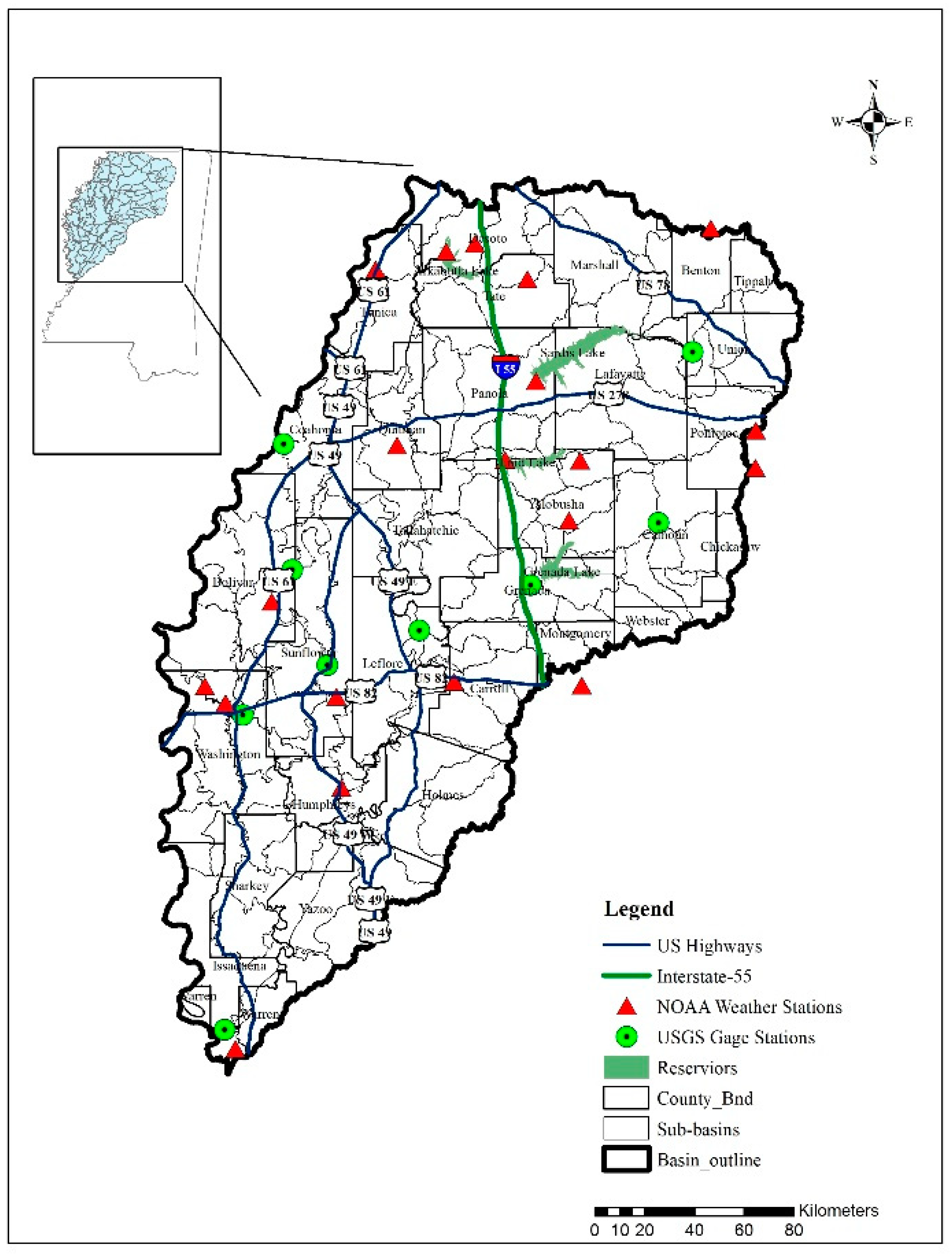
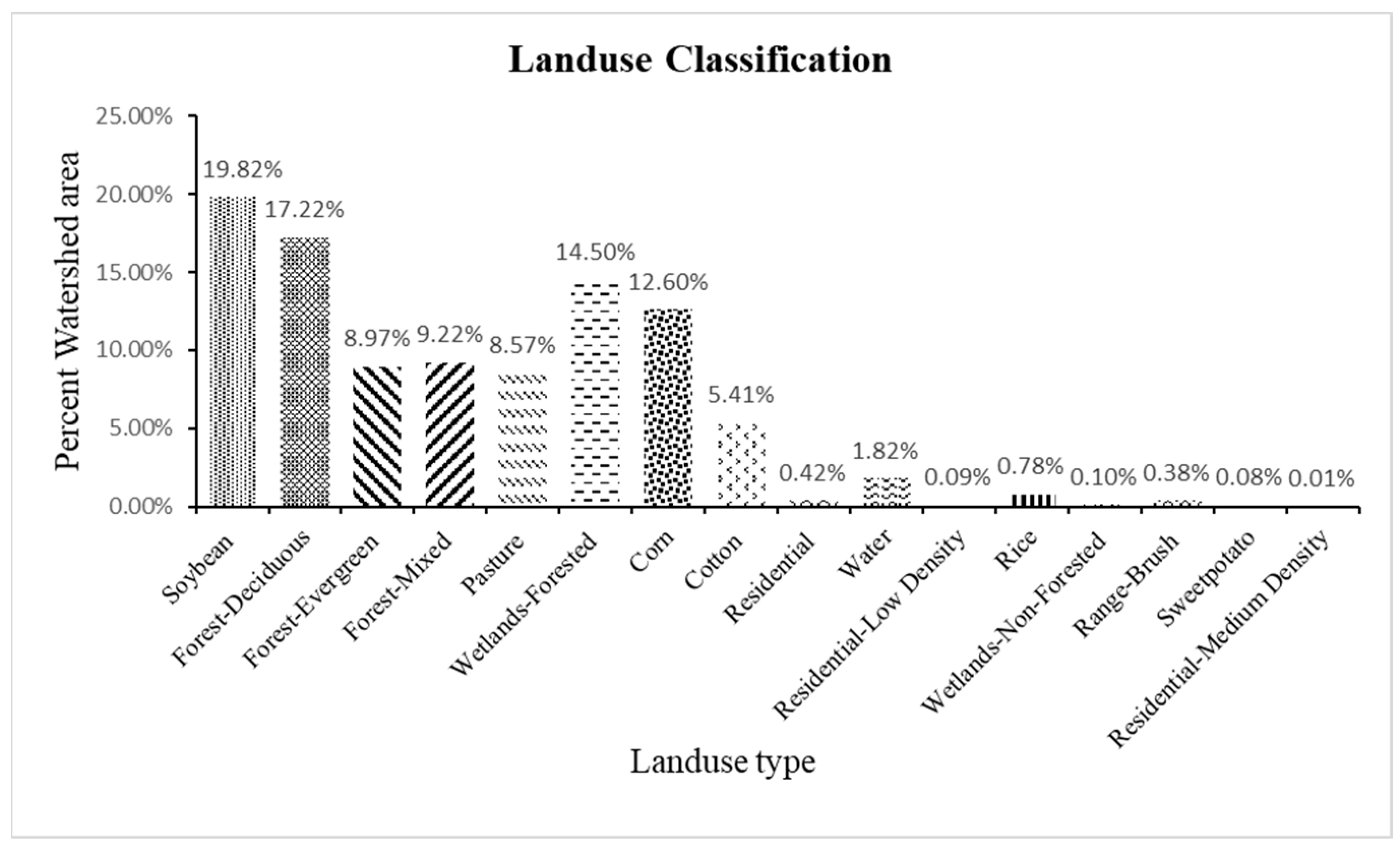

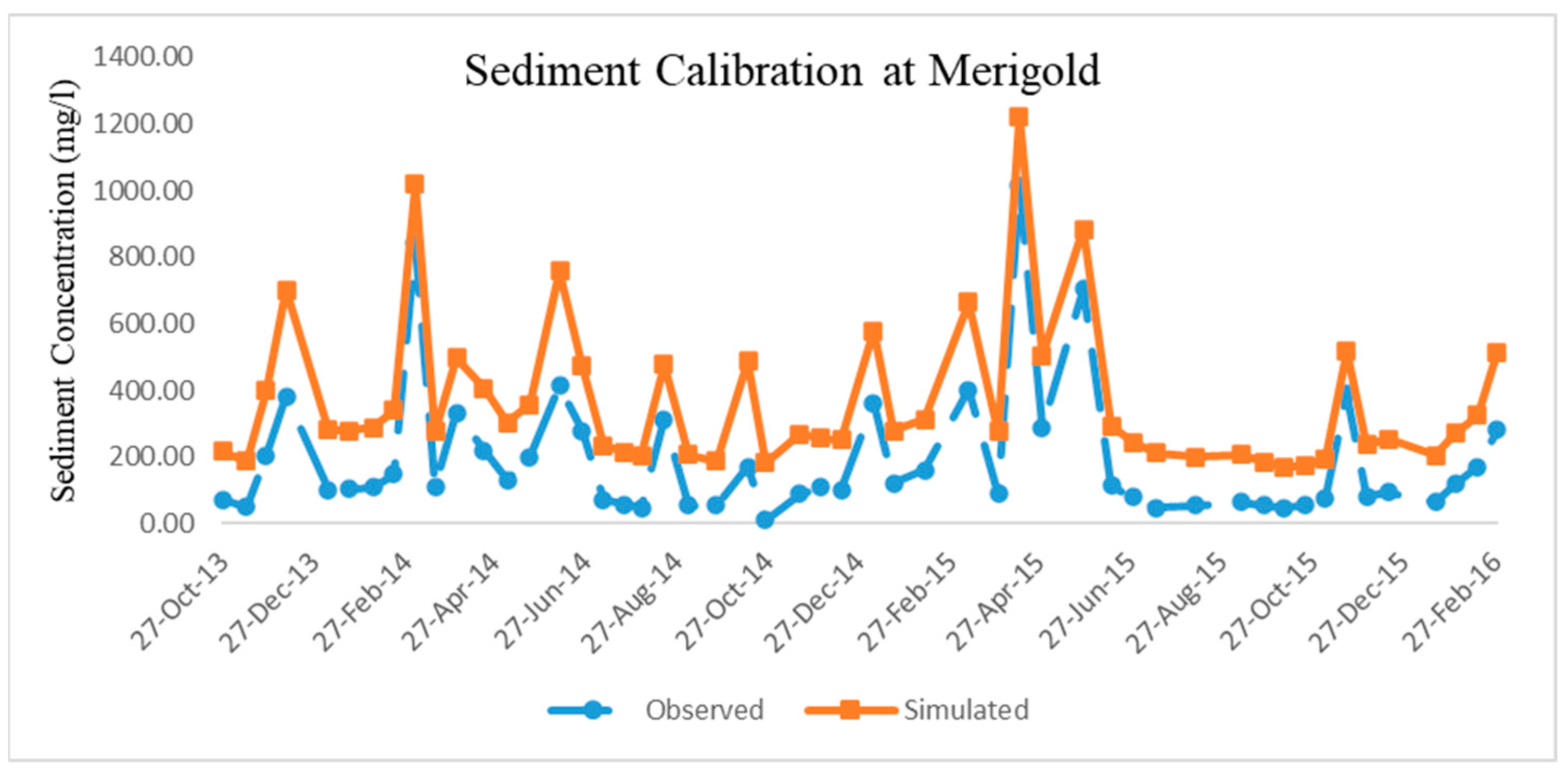
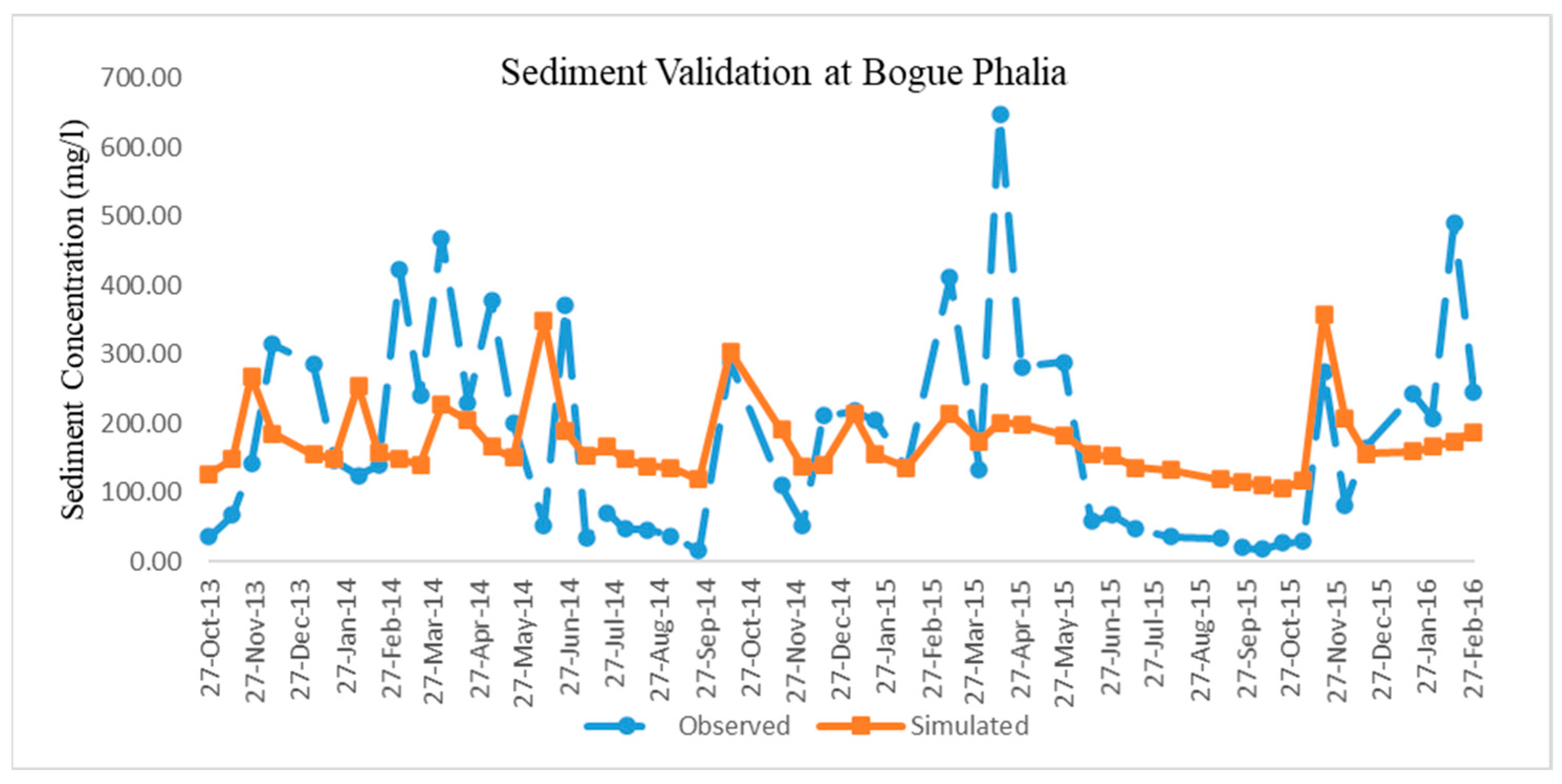
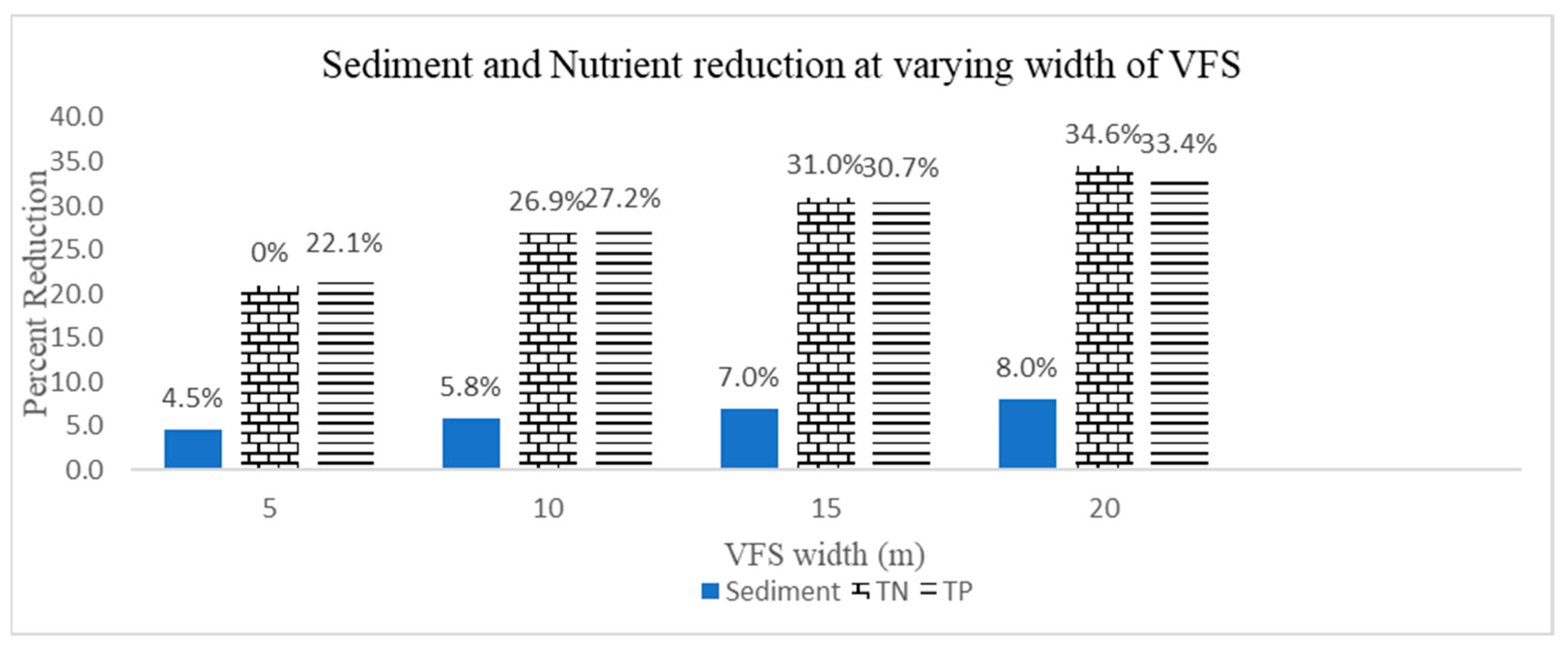
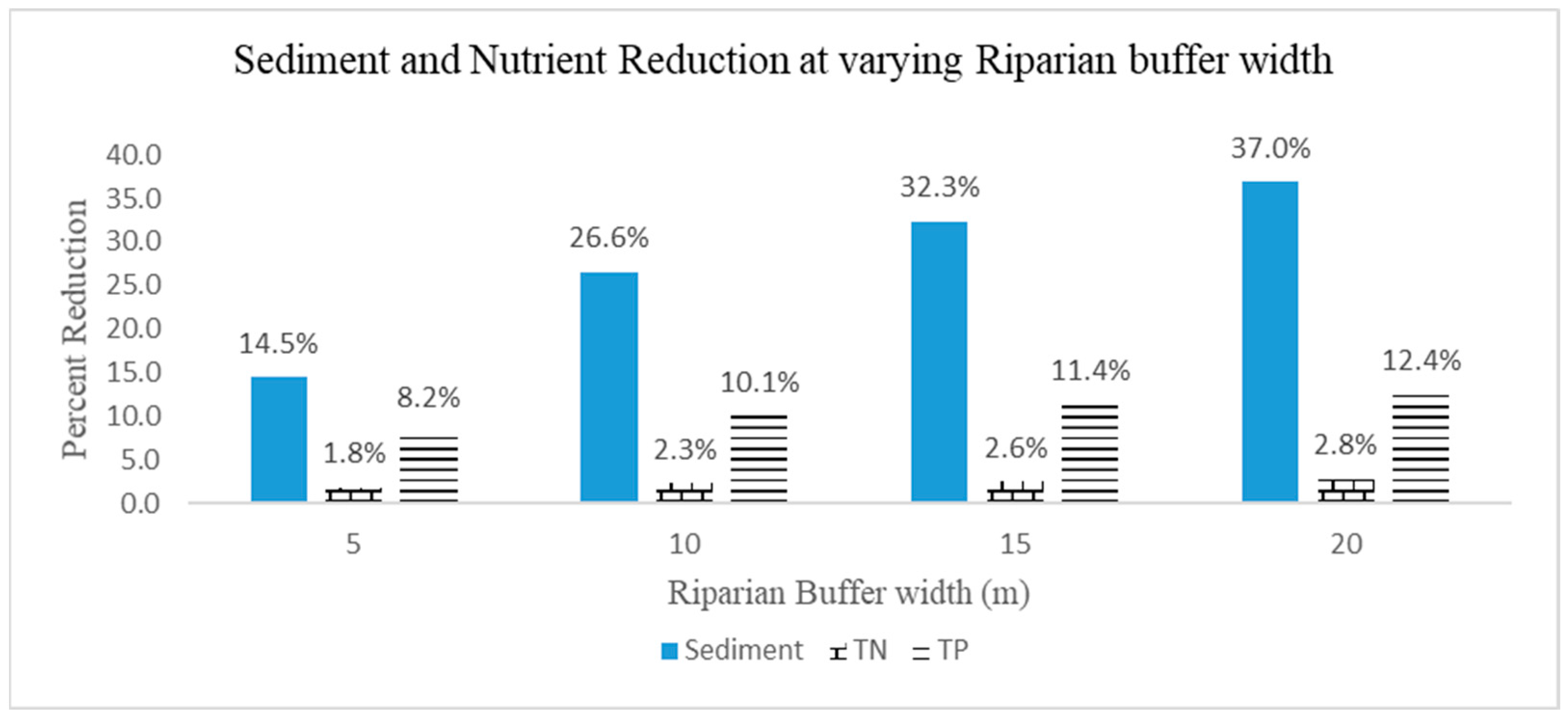


| Parameter Name | Fitted Value | Min_Value | Max_Value |
|---|---|---|---|
| R_CN2.mgt | −0.281491 | −0.611679 | −0.232775 |
| V_ALPHA_BF.gw | 0.154628 | −0.03763 | 0.426442 |
| V__GW_DELAY.gw | 169.28447 | 92.200127 | 278.26578 |
| V__GWQMN.gw | 4279.6025 | 2744.1755 | 5243.7075 |
| R__ESCO.hru | −0.658654 | −0.693971 | 0.130097 |
| R__SOL_AWC(..).sol | −0.288483 | −0.417682 | 0.278006 |
| V__GW_REVAP.gw | 0.038273 | −0.041752 | 0.077434 |
| R__SURLAG.bsn | 3.360117 | 1.552425 | 7.054097 |
| R__SOL_K(..).sol | 0.406588 | −0.061624 | 0.493882 |
| Parameter_Name | Fitted_Value |
|---|---|
| ch_cov1.rte | 0.03 |
| ch_cov2.rte | 0.035 |
| ERODMO.rte | 0.5 |
| PRF.rte | 0.57 |
| spcon.rte | 0.0006 |
| SLSUBBSN.hru | 137.5 |
| ADJ_PKR.bsn | 2 |
| USLE_K.sol | 0.2 |
| USLE_C.cropdat | 0.2 |
| USLE_P.mgt | 1 |
| Parameter Name | Fitted Value |
|---|---|
| RS3.swq | 0.11 |
| RS4.swq | 0.0076 |
| BC3.swq | 0.305 |
| BC2.swq | 1.19 |
| RCN.bsn | 0.54 |
| CMN.bsn | 0.0011 |
| CDN.bsn | 1.1 |
| SSDNCO.bsn | 0.85 |
| N_UPDIS.bsn | 15 |
| NPERCO | 0.25 |
| Parameter Name | Fitted Value |
|---|---|
| RS2.swq | 0.0965 |
| RS5.swq | 0.009 |
| BC4.swq | 0.0525 |
| BC2.swq | 1.19 |
| RCN.bsn | 0.54 |
| PSP.bsn | 0.4 |
| PERCOP.bsn | 0.8 |
| PHOSKD.bsn | 185 |
| P_UPDIS.bsn | 1 |
| PPERCO | 10.8 |
| Sc. No. | Gage Station | USGS Gauge Station Number | Subbasin No. | Calibration | Validation | ||
|---|---|---|---|---|---|---|---|
| R2 | NSE | R2 | NSE | ||||
| 1 | Yazoo River @ Steel Bayou (Vicksburg) | 7288955 | 107 | 0.36 | 0.30 | 0.76 | 0.74 |
| 2 | Tallahatchie River @ Money | 7281600 | 61 | 0.58 | 0.41 | 0.68 | 0.59 |
| 3 | Bouge Phalia near Leland | 7288650 | 78 | 0.80 | 0.80 | 0.75 | 0.74 |
| 4 | Little Tallahatchie @ Etta | 7268000 | 15 | 0.65 | 0.62 | 0.76 | 0.69 |
| 5 | Yalobusha @ Grenada | 7285500 | 54 | 0.47 | 0.47 | 0.16 | 0.12 |
| 6 | Skuna River | 7283000 | 40 | 0.62 | 0.61 | 0.69 | 0.57 |
| 7 | Big Sunflower @ Merigold | 7288280 | 47 | 0.62 | 0.60 | 0.7 | 0.59 |
| 8 | Big Sunflower @ Sunflower | 7288500 | 67 | 0.73 | 0.69 | 0.63 | 0.57 |
| Sediment | TN | TP | |||||
|---|---|---|---|---|---|---|---|
| Process | Station | R2 | NSE | R2 | NSE | R2 | NSE |
| Calibration | Big Sunflower at Merigold | 0.17 | 0.17 | 0.05 | 0.10 | 0.33 | 0.18 |
| Validation | Bouge Phalia near Leland | 0.17 | 0.14 | 0.08 | 0.13 | 0.41 | 0.33 |
| Width (m) | VFS | Riparian Buffer Width (m) | VFS + Riparian | ||||||
|---|---|---|---|---|---|---|---|---|---|
| Sediment | TN | TP | Sediment | TN | TP | Sediment | TN | TP | |
| 5 | 4.5 | 21.0 | 22.1 | 14.5 | 1.8 | 8.2 | 23.7 | 22.8 | 30.3 |
| 10 | 5.8 | 26.9 | 27.2 | 26.6 | 2.3 | 10.1 | 36.9 | 29.0 | 37.2 |
| 15 | 7.0 | 31.0 | 30.7 | 32.3 | 2.6 | 11.4 | 44.9 | 33.6 | 42.0 |
| 20 | 8.0 | 34.6 | 33.4 | 37.0 | 2.8 | 12.4 | 51.8 | 37.3 | 45.7 |
| Cover Crop (CC) | Percent Decrease | ||
|---|---|---|---|
| Streamflow | TN | TP | |
| Rye Grass | 5.3 | 16.3 | 10.6 |
| Winter Barley | 4.7 | 14.4 | 10.6 |
| Winter Wheat | 3.7 | 25.4 | 10.4 |
Publisher’s Note: MDPI stays neutral with regard to jurisdictional claims in published maps and institutional affiliations. |
© 2022 by the authors. Licensee MDPI, Basel, Switzerland. This article is an open access article distributed under the terms and conditions of the Creative Commons Attribution (CC BY) license (https://creativecommons.org/licenses/by/4.0/).
Share and Cite
Venishetty, V.; Parajuli, P.B. Assessment of BMPs by Estimating Hydrologic and Water Quality Outputs Using SWAT in Yazoo River Watershed. Agriculture 2022, 12, 477. https://doi.org/10.3390/agriculture12040477
Venishetty V, Parajuli PB. Assessment of BMPs by Estimating Hydrologic and Water Quality Outputs Using SWAT in Yazoo River Watershed. Agriculture. 2022; 12(4):477. https://doi.org/10.3390/agriculture12040477
Chicago/Turabian StyleVenishetty, Vivek, and Prem B. Parajuli. 2022. "Assessment of BMPs by Estimating Hydrologic and Water Quality Outputs Using SWAT in Yazoo River Watershed" Agriculture 12, no. 4: 477. https://doi.org/10.3390/agriculture12040477
APA StyleVenishetty, V., & Parajuli, P. B. (2022). Assessment of BMPs by Estimating Hydrologic and Water Quality Outputs Using SWAT in Yazoo River Watershed. Agriculture, 12(4), 477. https://doi.org/10.3390/agriculture12040477






